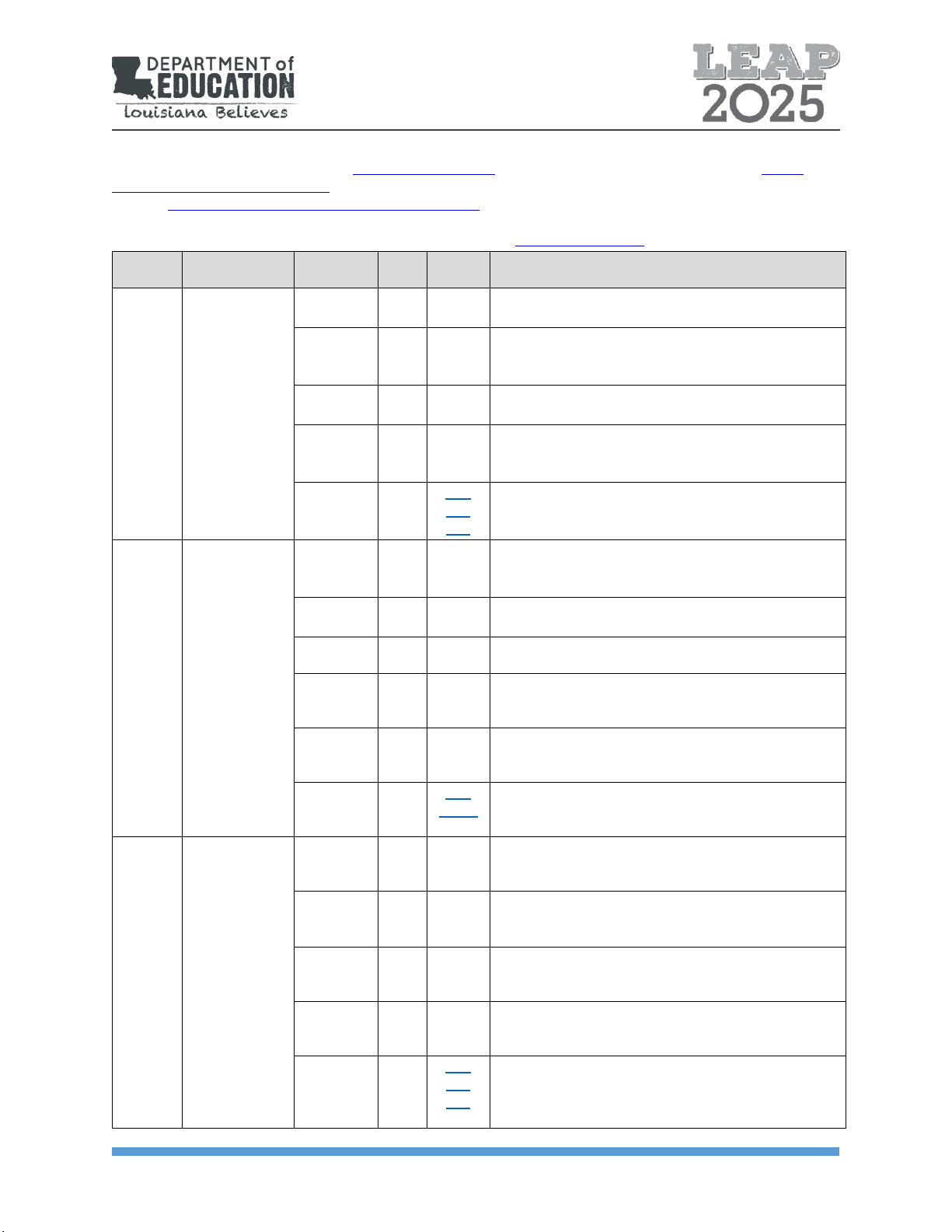
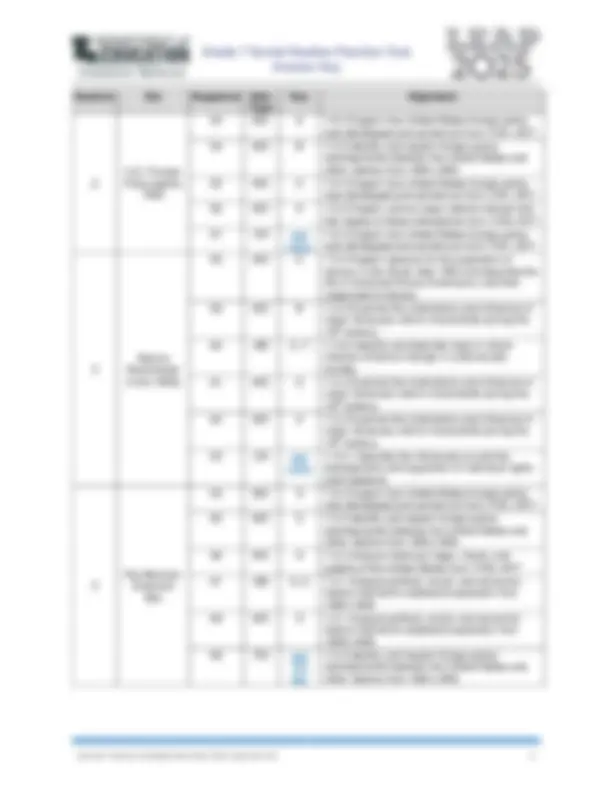
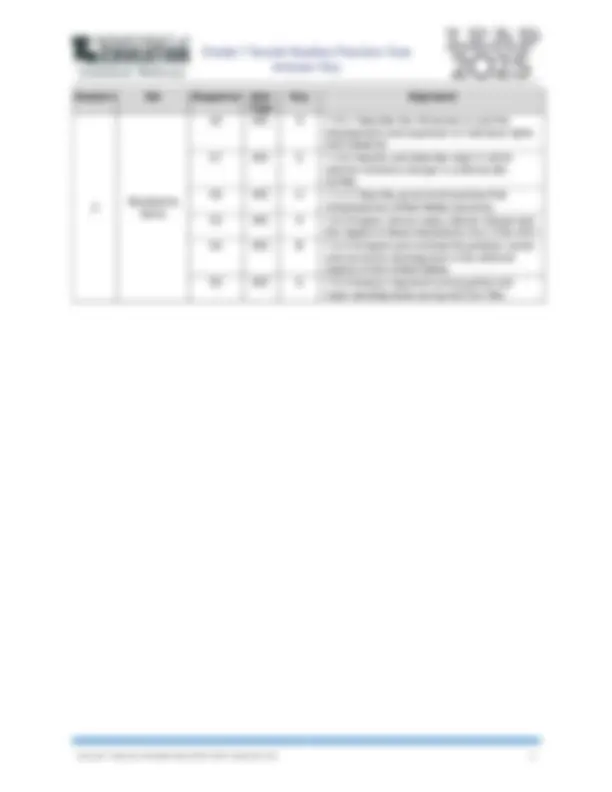
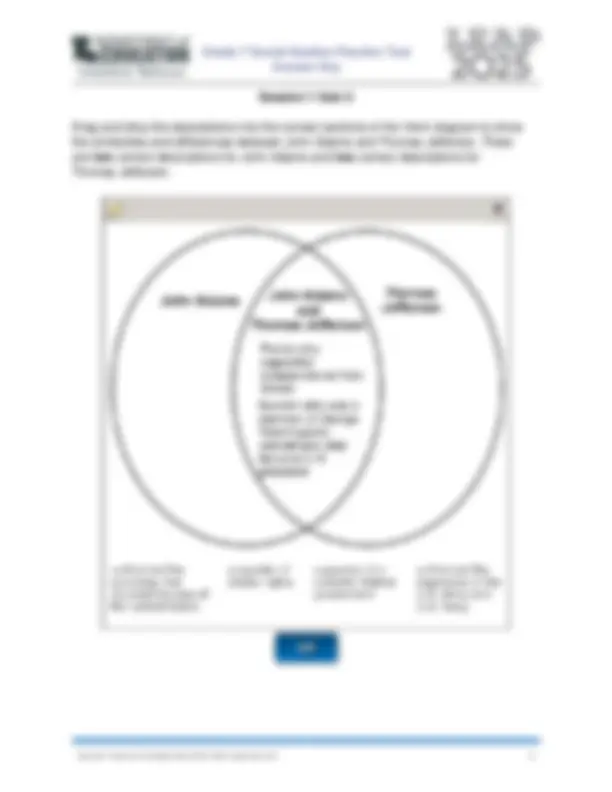
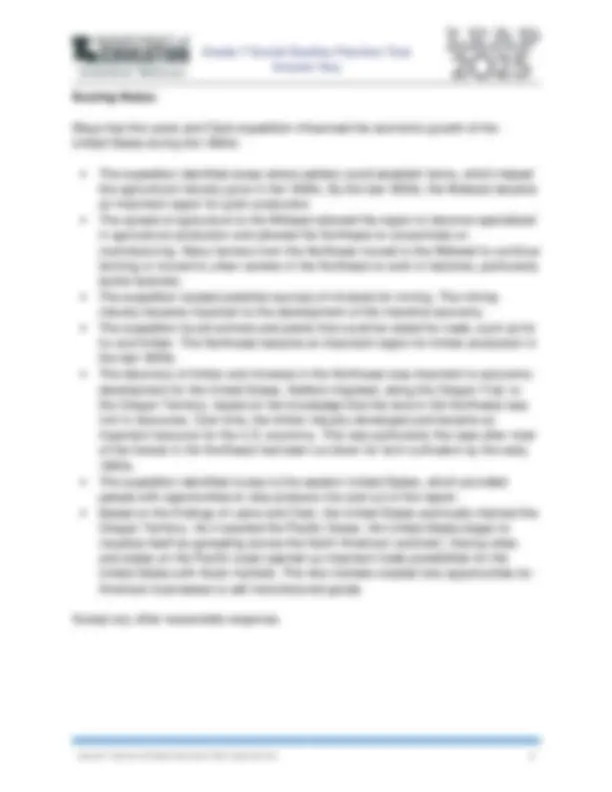
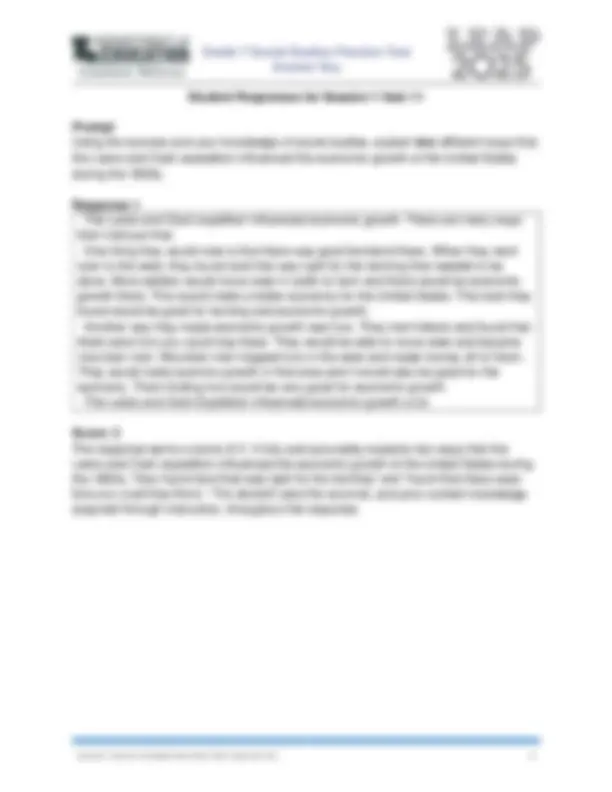
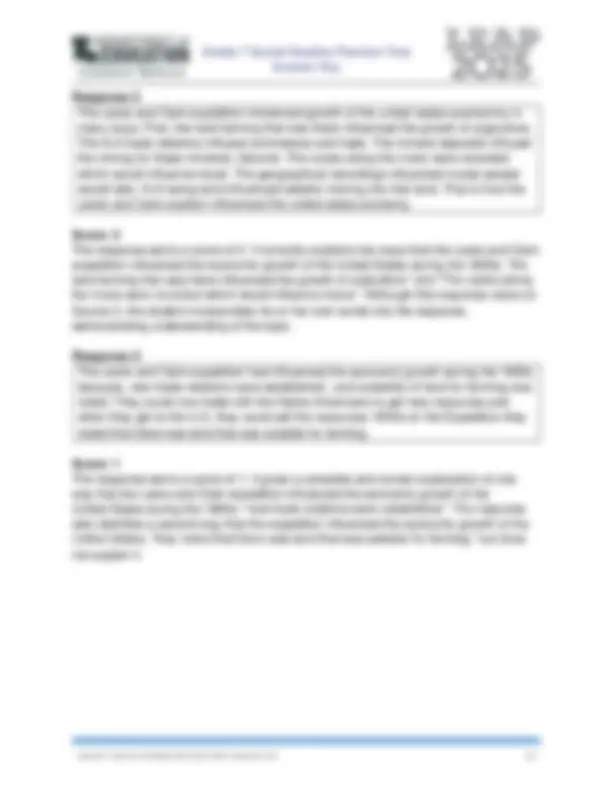
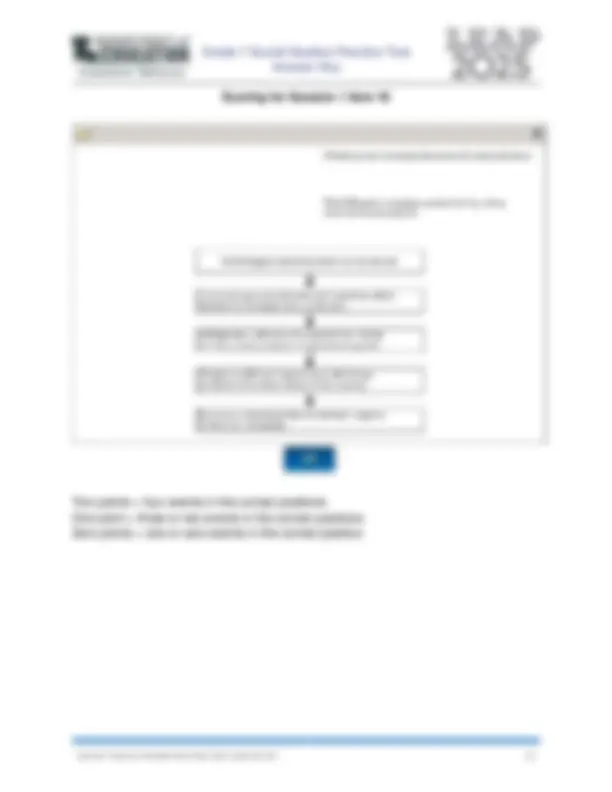
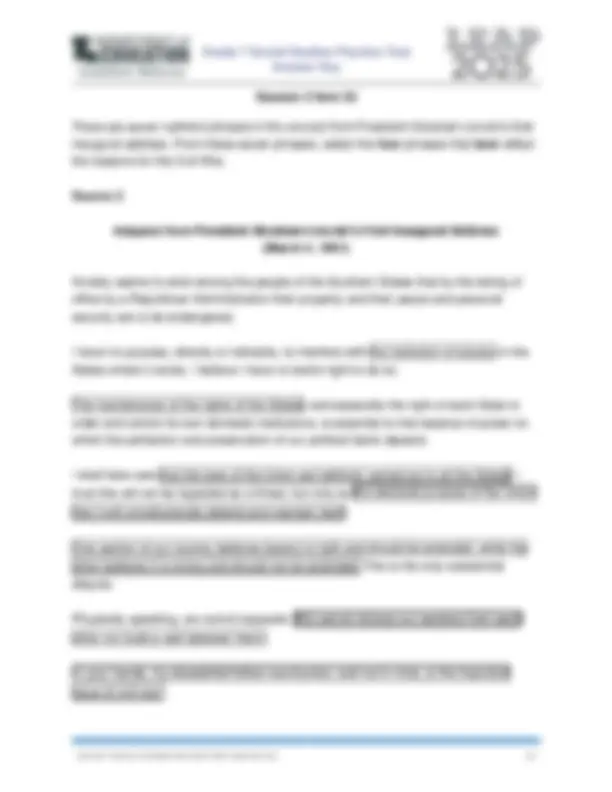
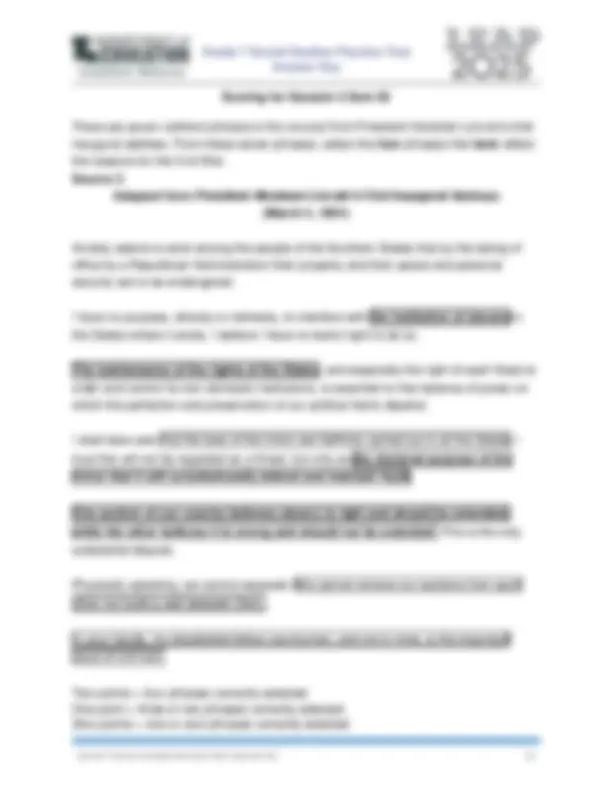
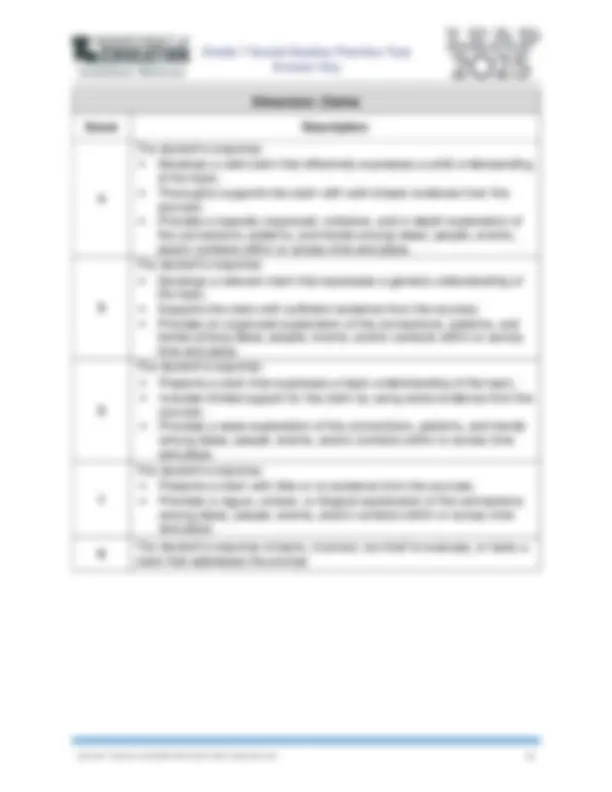
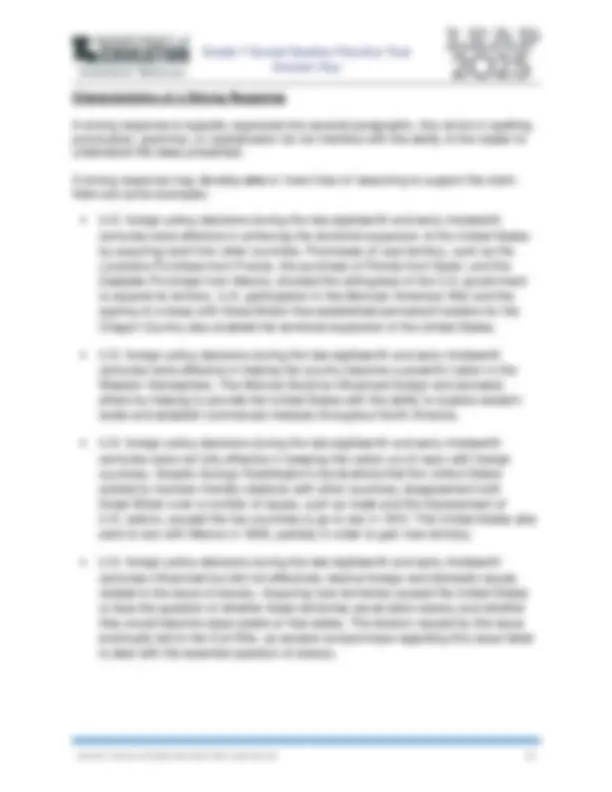
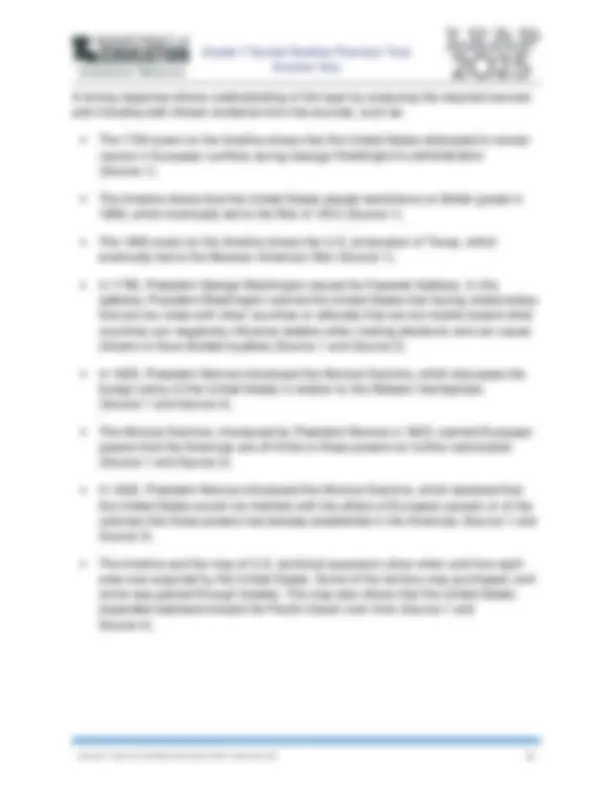
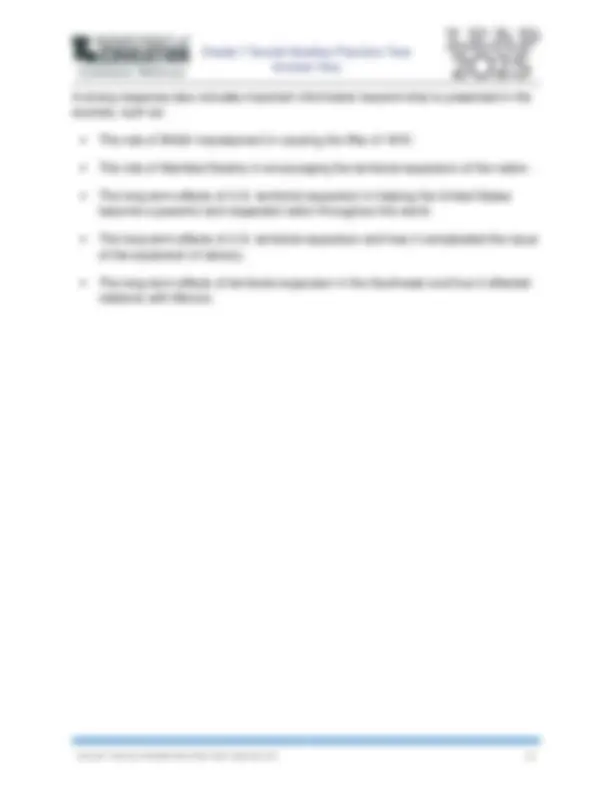
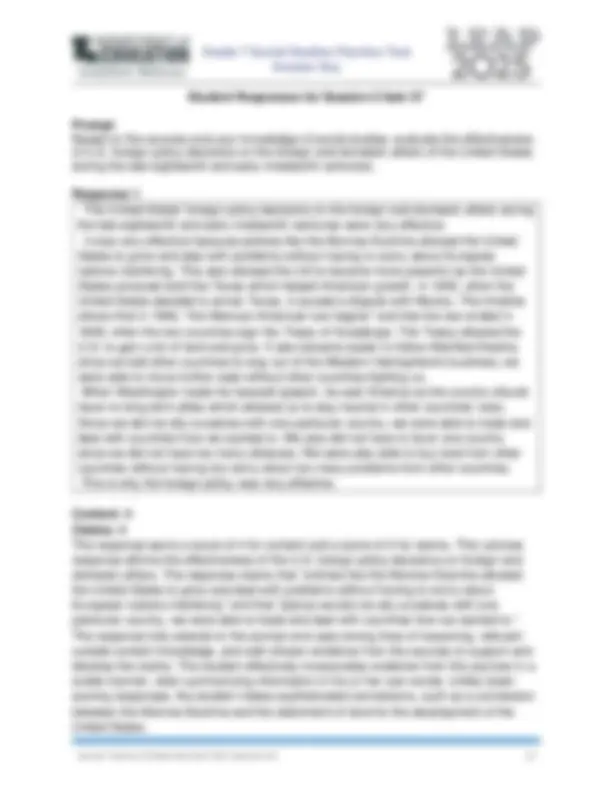
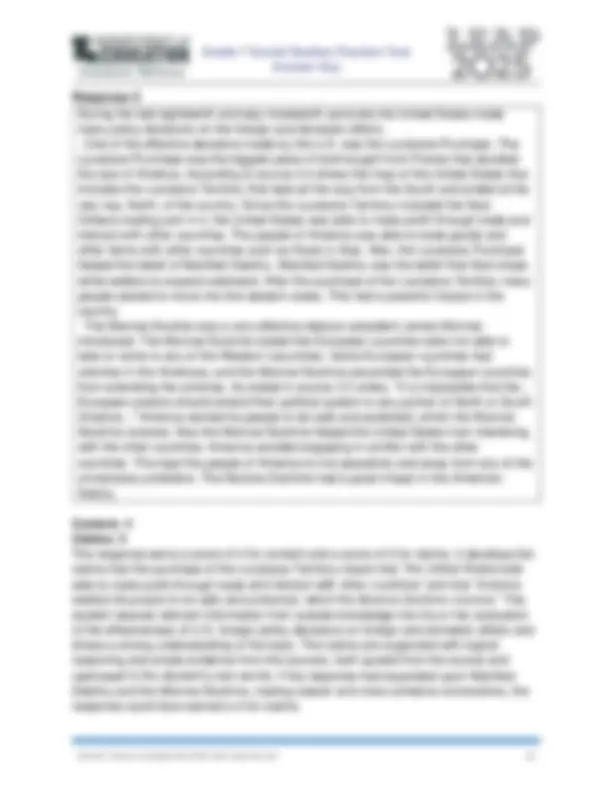
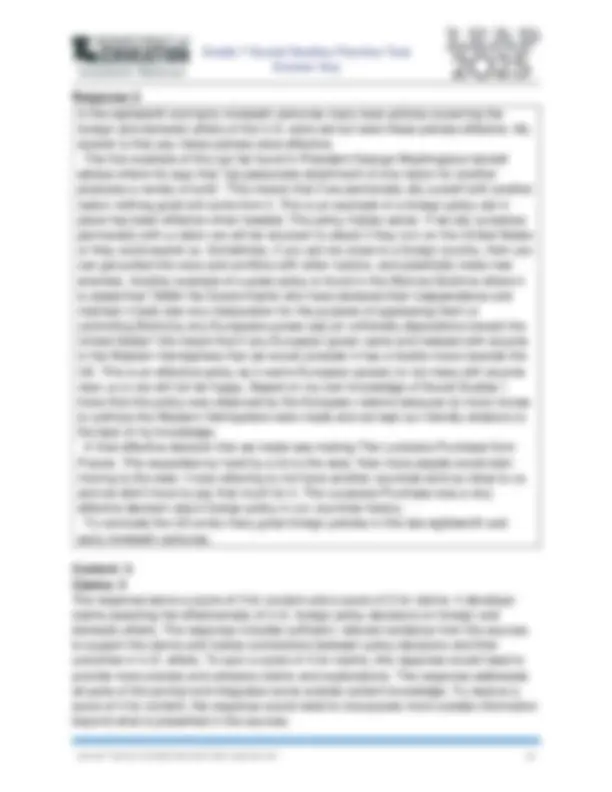
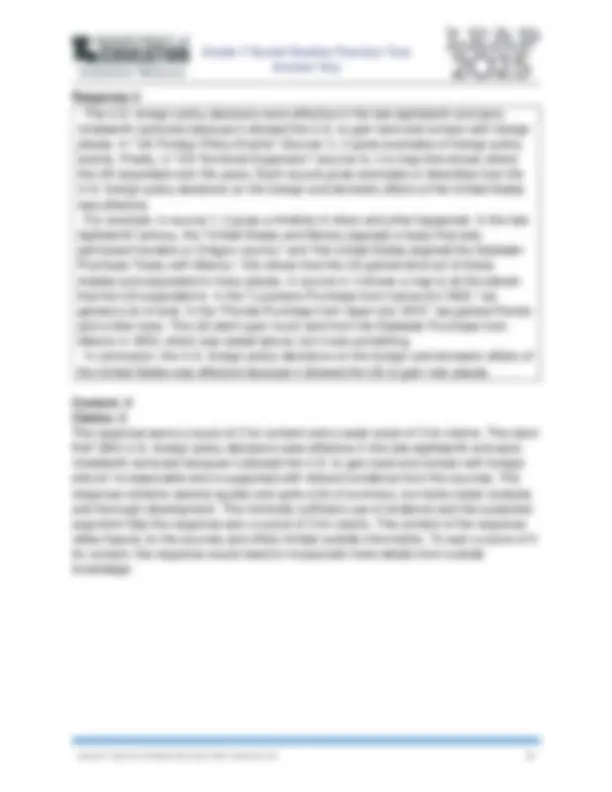
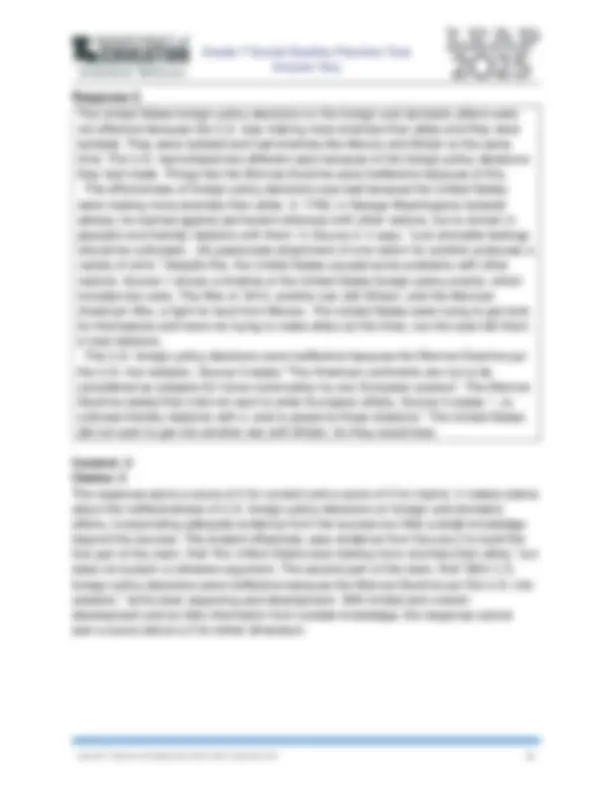
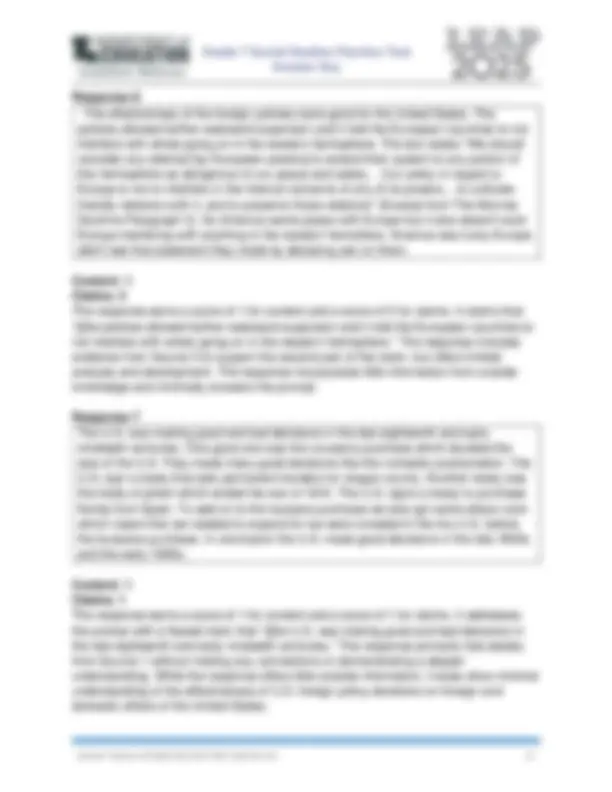
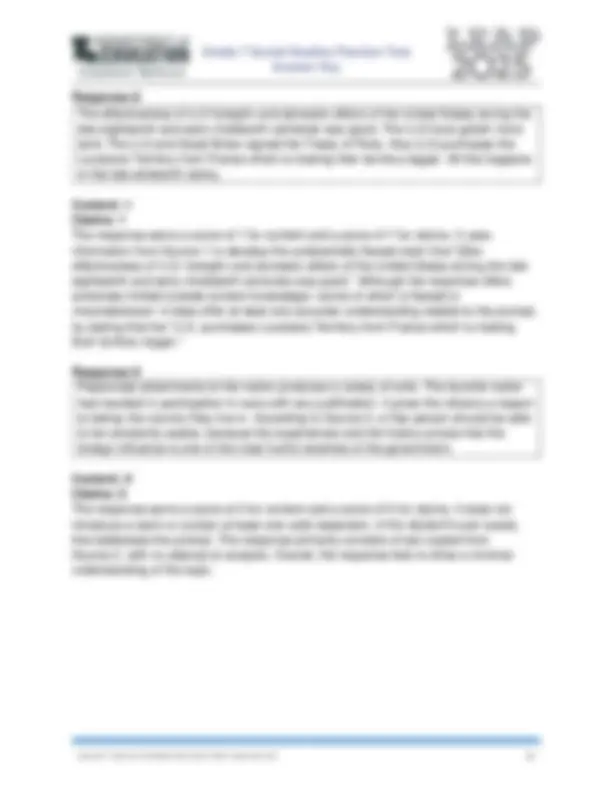
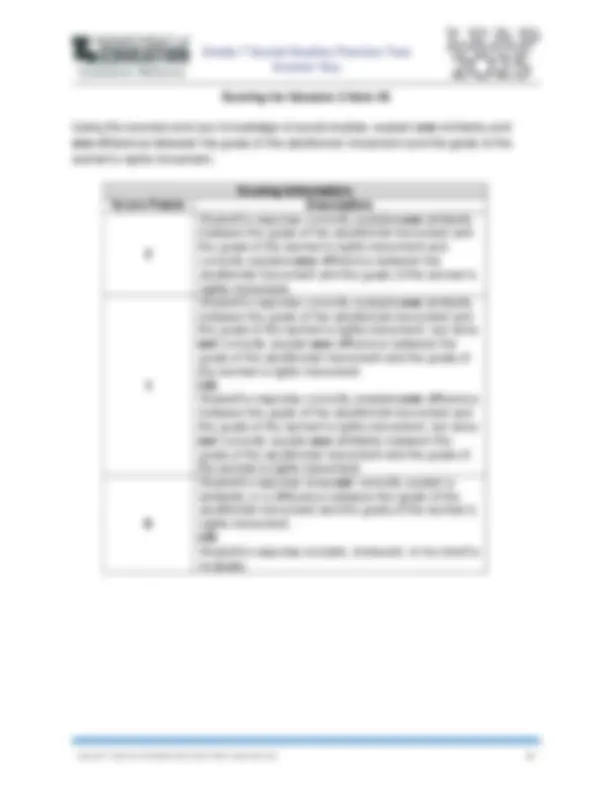
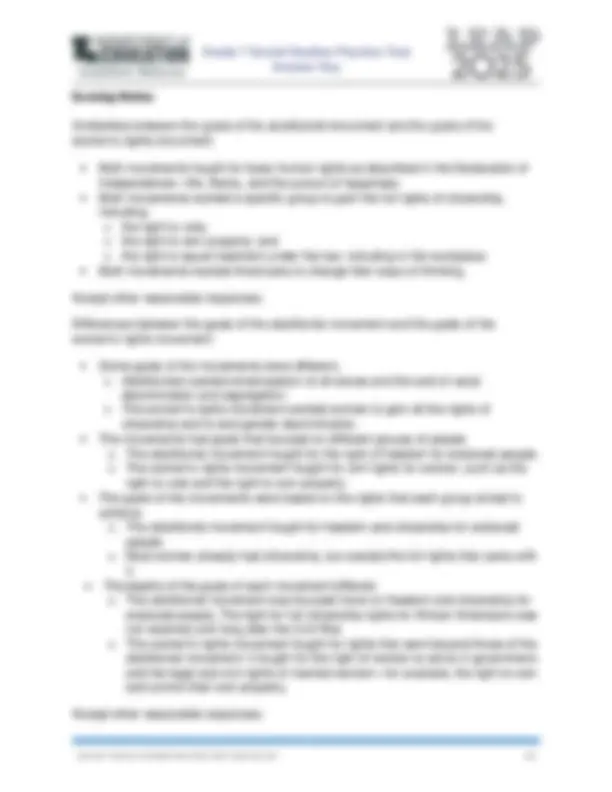
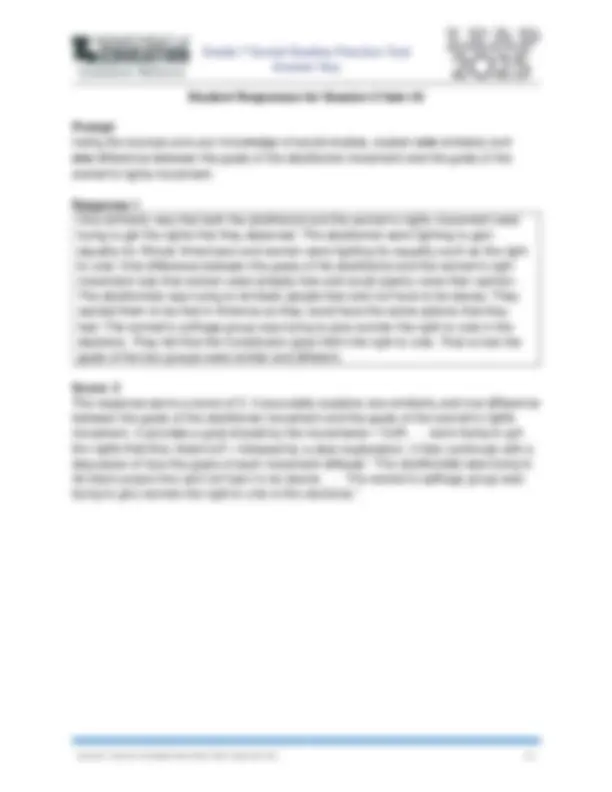
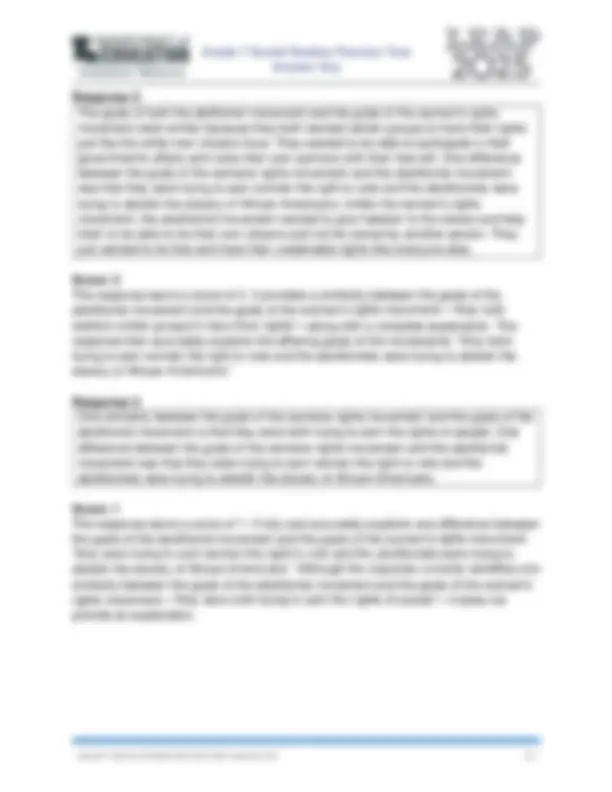
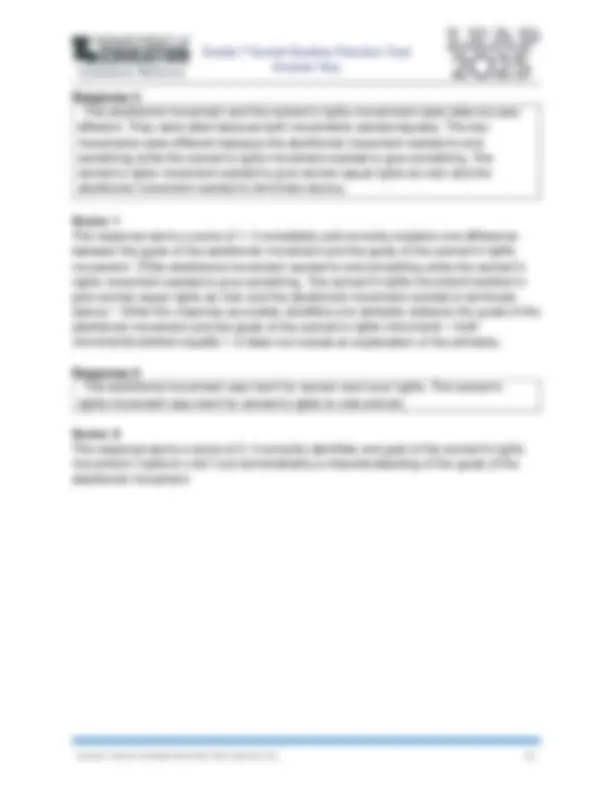
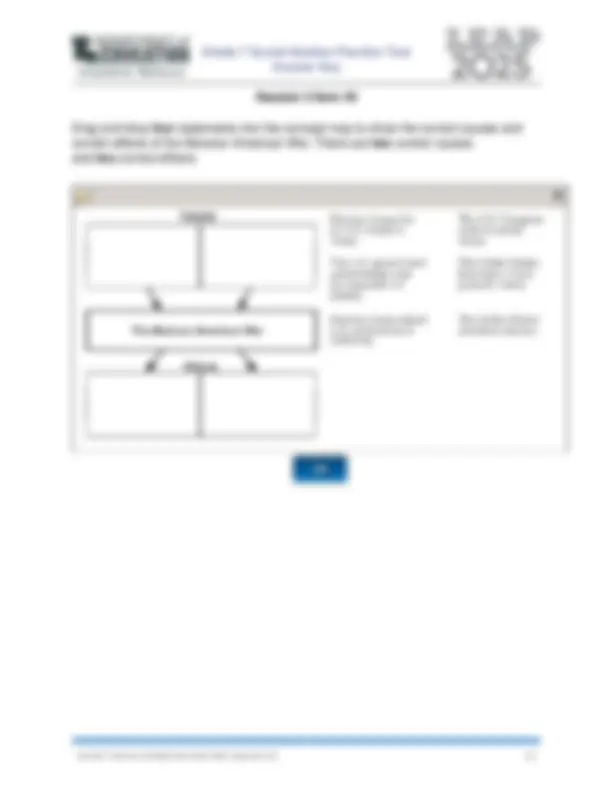
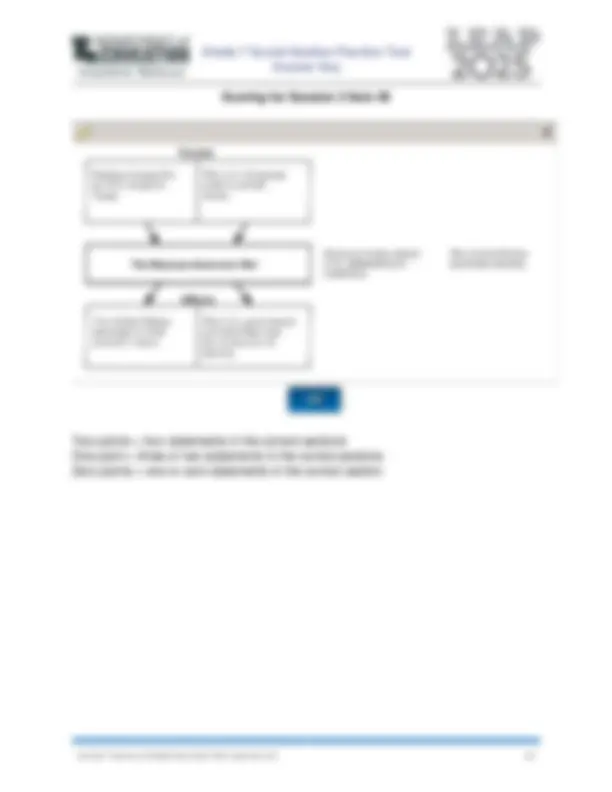


Study with the several resources on Docsity

Earn points by helping other students or get them with a premium plan


Prepare for your exams
Study with the several resources on Docsity

Earn points to download
Earn points by helping other students or get them with a premium plan
Community
Ask the community for help and clear up your study doubts
Discover the best universities in your country according to Docsity users
Free resources
Download our free guides on studying techniques, anxiety management strategies, and thesis advice from Docsity tutors
1. MC. C. 7.8.5 Describe the structure and powers of the three branches of the federal government. 2. MC. A. 7.10.1 Describe the influences on and the.
Typology: Study Guides, Projects, Research
1 / 35

This page cannot be seen from the preview
Don't miss anything!




























Answer Key This document contains the answer keys, rubrics, and scoring notes for items on the grade 7 Social Studies Practice Test. Refer to the Practice Test Library for additional resources, including the Social Studies Practice Test Guidance, which provides general supports and cautions in using the practice test, and the Annotated Social Studies Practice Test Items document, which explains the purpose and reasoning of selected practice tests items. For additional help in scoring constructed- and extended- response items, refer to the presentation and materials for Social Studies 101. Session Set Sequence Item Type Key Alignment 1 John Adams and Thomas Jefferson 1 MC C (^) 7.8.5 Describe the structure and powers of the three branches of the federal government 2 MC A (^) 7.10.1 Describe the influences on and the development and expansion of individual rights and freedoms 3 MC B (^) 7.10.2 Identify and describe ways in which citizens influence change in a democratic society 4 MC D (^) 7.10.1 Describe the influences on and the development and expansion of individual rights and freedoms 5 TEI see TEI key 7.2.4 Describe the major political and economic events, and policies of the Washington and Adams presidencies 1 The Lewis and Clark Expedition 6 MC C (^) 7.3.2 Identify and explain foreign policy developments between the United States and other nations from 1800– 1850 7 MC B (^) 7.11.3 Describe government policies that influenced the United States economy 8 MC B 7.5.3 Analyze historical maps, charts, and graphs of the United States from 1763– 1877 9 MS A, E 7.3.1 Analyze political, social, and economic factors that led to westward expansion from 1800 – 1850 10 MS A, B, D 7.3.1 Analyze political, social, and economic factors that led to westward expansion from 1800 – 1850 11 CR see rubric 7.3.1 Analyze political, social, and economic factors that led to westward expansion from 1800 – 1850 1 Regional Economies of the United States 12 MC C 7.11.1 Explain how the demand for resources and the development of technology influenced economic diversity in the United States 13 MC A 7.6.3 Analyze patterns, motivations and the impact of rural and urban migration in the United States from 1763– 1877 14 MS B, E, F 7.3.4 Compare and contrast the political, social, and economic development of the different regions of the United States 15 MC B 7.11.1 Explain how the demand for resources and the development of technology influenced economic diversity in the United States 16 TEI see TEI key 7.11.2 Explain how economic interdependence developed between regions of the United States and with foreign countries
Answer Key Session Set Sequence Item Type Key Alignment 1 Reconstruction 17 MC C 7.4.3 Describe long-term and short-term outcomes of Reconstruction 18 MS B, F 7.4.3 Describe long-term and short-term outcomes of Reconstruction 19 MC A 7.4.3 Describe long-term and short-term outcomes of Reconstruction 20 MC B 7.8.8 Examine how key legislation and court decisions influenced the course of United States history from 1763– 1877 1 Standalone Items 21 MC A 7.11.3 Describe government policies that influenced the United States economy 22 MC C 7.7.1 Explain how Americans adapted and transformed various physical environments in the United States to expand its growth and influence 23 MC D 7.6.4 Explain how differences in land use influenced cultural characteristics among regions in the United States from 1763– 1877 24 MC B 7.3.1 Analyze political, social, and economic factors that led to westward expansion from 1800 – 1850 25 MC C 7.6.1 Analyze settlement patterns of racial and ethnic groups in the United States from 1763 – 1877 26 MC B 7.10.5 Describe the development and roles of political parties and special interest groups in the United States from 1787– 1877 2 Election of Abraham Lincoln 27 MC B 7.4.1 Identify and describe the role of the election of Abraham Lincoln and other key events, ideas, and people, which led to the Civil War 28 MS A, E 7.4.1 Identify and describe the role of the election of Abraham Lincoln and other key events, ideas, and people, which led to the Civil War 29 MC B 7.8.9 Explain how federal officials are elected or appointed 30 MC C 7.5.3 Analyze historical maps, charts, and graphs of the United States from 1763– 1877 31 MC D 7.4.2 Analyze important turning points and major developments during the Civil War 32 TEI see TEI key 7.4.1 Identify and describe the role of the election of Abraham Lincoln and other key events, ideas, and people, which led to the Civil War
Answer Key Session Set Sequence Item Type Key Alignment 3 Standalone Items 50 MC D 7.10.1 Describe the influences on and the development and expansion of individual rights and freedoms 51 MC C 7.10.2 Identify and describe ways in which citizens influence change in a democratic society 52 MC C 7.11.3 Describe government policies that influenced the United States economy 53 MC A 7.9.2 Explain various ways nations interact and the impact of these interactions from 1763– 1877 54 MC B 7.3.4 Compare and contrast the political, social, and economic development of the different regions of the United States 55 MC A 7.4.2 Analyze important turning points and major developments during the Civil War
Answer Key Session 1 Item 5 Drag and drop the descriptions into the correct sections of the Venn diagram to show the similarities and differences between John Adams and Thomas Jefferson. There are two correct descriptions for John Adams and two correct descriptions for Thomas Jefferson.
Answer Key Scoring for Session 1 Item 1 1 Using the sources and your knowledge of social studies, explain two different ways that the Lewis and Clark expedition influenced the economic growth of the United States during the 1800s. Scoring Information Score Points Description 2 Student’s response correctly explains two different ways that the Lewis and Clark expedition influenced the economic growth of the United States during the 1800s. 1 Student’s response correctly explains one way that the Lewis and Clark expedition influenced the economic growth of the United States during the 1800s. 0 Student’s response does not correctly explain a way that the Lewis and Clark expedition influenced the economic growth of the United States during the 1800s. OR Student’s response is blank, irrelevant, or too brief to evaluate.
Answer Key Scoring Notes: Ways that the Lewis and Clark expedition influenced the economic growth of the United States during the 1800s: The expedition identified areas where settlers could establish farms, which helped the agricultural industry grow in the 1800s. By the late 1800s, the Midwest became an important region for grain production. The spread of agriculture to the Midwest allowed the region to become specialized in agricultural production and allowed the Northeast to concentrate on manufacturing. Many farmers from the Northeast moved to the Midwest to continue farming or moved to urban centers in the Northeast to work in factories, particularly textile factories. The expedition located potential sources of minerals for mining. The mining industry became important to the development of the industrial economy. The expedition found animals and plants that could be raised for trade, such as for fur and timber. The Northwest became an important region for timber production in the late 1800s. The discovery of timber and minerals in the Northwest was important to economic development for the United States. Settlers migrated, along the Oregon Trail, to the Oregon Territory, based on the knowledge that the land in the Northwest was rich in resources. Over time, the timber industry developed and became an important resource for the U.S. economy. This was particularly the case after most of the forests in the Northeast had been cut down for farm cultivation by the early 1800s. The expedition identified routes to the western United States, which provided people with opportunities to ship products into and out of the region. Based on the findings of Lewis and Clark, the United States eventually claimed the Oregon Territory. As it reached the Pacific Ocean, the United States began to visualize itself as spreading across the North American continent. Having cities and states on the Pacific coast opened up important trade possibilities for the United States with Asian markets. The new markets created new opportunities for American businesses to sell manufactured goods. Accept any other reasonable response.
Answer Key Response 2 The Lewis and Clark expitdition infulenced growth of the united states ecomenmy in many ways. First, the land farming that was there influenced the growth of argiculture. The N.A trade relations influced commerece and trade. The mineral depositis influced the mining for these minerals. Second, The routes along the rivers were recorded which would influence travel. The geograpihcal recordings influenced routes people would take. N.A losing land influenced settelrs moving into that land. That is how the Lewis and Clark expition influenced the united states econemy. Score: 2 The response earns a score of 2. It correctly explains two ways that the Lewis and Clark expedition influenced the economic growth of the United States during the 1800s: “the land farming that was there influenced the growth of argiculture” and “The routes along the rivers were recorded which would influence travel.” Although this response relies on Source 3 , the student incorporates his or her own words into the response, demonstrating understanding of the topic. Response 3 The Lewis and Clark expedition had influenced the economic growth during the 1800s because, new trade relations were established , and suitability of land for farming was noted. They could now trade with the Native Americans to get new resources and when they get to the U.S. they could sell the resources. While on the Expedition they noted that there was land that was suitable for farming. Score: 1 The response earns a score of 1. It gives a complete and correct explanation of one way that the Lewis and Clark expedition influenced the economic growth of the United States during the 1800s: “new trade relations were established.” The response also identifies a second way that the expedition influenced the economic growth of the United States, “they noted that there was land that was suitable for farming,” but does not explain it.
Answer Key Response 4 Two ways that the lewis and Clark expedition infuenced the economic growth of the United states. It enfuenced it by showing them how to grow, what new plants and animals were there and where there was lakes, rivers and also told them a good spot to start there economy. The Lewis and Clark expedition was to talk to the Native Americans and to see how they lived there and to make freinds with them.They found alot of new stuff and new ways to live. So that they could live. The other thing is that they found ways to plant food and haw to live. Score: 1 The response earns a score of 1. It correctly explains one way that the Lewis and Clark expedition influenced the economic growth of the United States during the 1800s: “showing them how to grow, what new plants and animals were there and where there was lakes, rivers and also told them a good spot to start there economy.” It also identifies a second way that the Lewis and Clark expedition influenced the economic growth of the United States during the 1800s, “to talk to the Native Americans and to see how they lived there and to make freinds with them,” but does not offer a complete explanation. Response 5 The lewis and clark's expidition influenced the economic growth by trading with the native americans and by having the settlers learn the indian's laguage and culture. Score: 0 The response earns a score of 0. It identifies two ways that the Lewis and Clark expedition influenced the economic growth of the United States during the 1800s, but it does not provide any explanation.
Answer Key Scoring for Session 1 Item 16 Two points = four events in the correct positions One point = three or two events in the correct positions Zero points = one or zero events in the correct position
Answer Key Session 2 Item 32 There are seven outlined phrases in the excerpt from President Abraham Lincoln’s first inaugural address. From these seven phrases, select the four phrases that best reflect the reasons for the Civil War. Source 3 Adapted from President Abraham Lincoln’s First Inaugural Address (March 4, 1861) Anxiety seems to exist among the people of the Southern States that by the taking of office by a Republican Administration their property and their peace and personal security are to be endangered. I have no purpose, directly or indirectly, to interfere with the institution of slavery in the States where it exists. I believe I have no lawful right to do so. The maintenance of the rights of the States, and especially the right of each State to order and control its own domestic institutions, is essential to that balance of power on which the perfection and preservation of our political fabric depend. I shall take care that the laws of the Union are faithfully carried out in all the States. I trust this will not be regarded as a threat, but only as the declared purpose of the Union that it will constitutionally defend and maintain itself. One section of our country believes slavery is right and should be extended, while the other believes it is wrong and should not be extended. This is the only substantial dispute. Physically speaking, we cannot separate. We cannot remove our sections from each other nor build a wall between them. In your hands, my dissatisfied fellow-countrymen, and not in mine, is the important issue of civil war.
Answer Key Scoring for Session 2 Item 3 7 Based on the sources and your knowledge of social studies, evaluate the effectiveness of U.S. foreign policy decisions on the foreign and domestic affairs of the United States during the late eighteenth and early nineteenth centuries. As you write, follow the directions below. Address all parts of the prompt. Include information and examples from your own knowledge of social studies. Use evidence from the sources to support your response.
Answer Key Scoring The response should be scored holistically on its adherence to two dimensions: Content and Claims. Each response should be given the score that corresponds to the set of bulleted descriptors that best describes the response. Dimension: Content Score Description 4 The student’s response: Reflects thorough knowledge of the effectiveness of U.S. foreign policy decisions on the foreign and domestic affairs of the United States during the late eighteenth and early nineteenth centuries by incorporating ample, focused factual information from prior knowledge and the sources; Contains accurate understandings with no errors significant enough to detract from the overall content of the response; Fully addresses all parts of the prompt. 3 The student’s response: Reflects general knowledge of the effectiveness of U.S. foreign policy decisions on the foreign and domestic affairs of the United States during the late eighteenth and early nineteenth centuries by incorporating adequate factual information from prior knowledge and the sources; Contains mostly accurate understandings with minimal errors that do not substantially detract from the overall content of the response; Addresses all parts of the prompt. 2 The student’s response: Reflects limited knowledge of the effectiveness of U.S. foreign policy decisions on the foreign and domestic affairs of the United States during the late eighteenth and early nineteenth centuries by incorporating some factual information from prior knowledge and the sources ; Contains some accurate understandings with a few errors that detract from the overall content of the response; Addresses part of the prompt. 1 The student’s response: Reflects minimal knowledge of the effectiveness of U.S. foreign policy decisions on the foreign and domestic affairs of the United States during the late eighteenth and early nineteenth centuries by incorporating little or no factual information from prior knowledge and the sources ; Contains few accurate understandings with several errors that detract from the overall content of the response; Minimally addresses part of the prompt. 0 The student’s response is^ blank,^ incorrect,^ or does not address the prompt.
Answer Key Characteristics of a Strong Response A strong response is logically organized into several paragraphs. Any errors in spelling, punctuation, grammar, or capitalization do not interfere with the ability of the reader to understand the ideas presented. A strong response may develop one or more lines of reasoning to support the claim. Here are some examples: U.S. foreign policy decisions during the late eighteenth and early nineteenth centuries were effective in achieving the territorial expansion of the United States by acquiring land from other countries. Purchases of vast territory, such as the Louisiana Purchase from France, the purchase of Florida from Spain, and the Gadsden Purchase from Mexico, showed the willingness of the U.S. government to expand its territory. U.S. participation in the Mexican-American War and the signing of a treaty with Great Britain that established permanent borders for the Oregon Country also enabled the territorial expansion of the United States. U.S. foreign policy decisions during the late eighteenth and early nineteenth centuries were effective in helping the country become a powerful nation in the Western Hemisphere. The Monroe Doctrine influenced foreign and domestic affairs by helping to provide the United States with the ability to explore western lands and establish commercial interests throughout North America. U.S. foreign policy decisions during the late eighteenth and early nineteenth centuries were not fully effective in keeping the nation out of wars with foreign countries. Despite George Washington’s declarations that the United States wished to maintain friendly relations with other countries, disagreement with Great Britain over a number of issues, such as trade and the impressment of U.S. sailors, caused the two countries to go to war in 1812. The United States also went to war with Mexico in 1846, partially in order to gain new territory. U.S. foreign policy decisions during the late eighteenth and early nineteenth centuries influenced but did not effectively resolve foreign and domestic issues related to the issue of slavery. Acquiring new territories caused the United States to face the question of whether these territories would allow slavery and whether they would become slave states or free states. The tension caused by this issue eventually led to the Civil War, as several compromises regarding this issue failed to deal with the essential question of slavery.
Answer Key A strong response shows understanding of the topic by analyzing the required sources and including well-chosen evidence from the sources, such as: The 1793 event on the timeline shows that the United States attempted to remain neutral in European conflicts during George Washington’s administration (Source 1). The timeline shows that the United States placed restrictions on British goods in 1806 , which eventually led to the War of 1812 (Source 1). The 1845 event on the timeline shows the U.S. annexation of Texas, which eventually led to the Mexican-American War (Source 1). In 1796, President George Washington issued his Farewell Address. In this address, President Washington warned the United States that having relationships that are too close with other countries or attitudes that are too hostile toward other countries can negatively influence leaders when making decisions and can cause citizens to have divided loyalties (Source 1 and Source 2). In 1823, President Monroe introduced the Monroe Doctrine, which discusses the foreign policy of the United States in relation to the Western Hemisphere (Source 1 and Source 3). The Monroe Doctrine, introduced by President Monroe in 1823, warned European powers that the Americas are off-limits to those powers for further colonization (Source 1 and Source 3). In 1823, President Monroe introduced the Monroe Doctrine, which declared that the United States would not interfere with the affairs of European powers or of the colonies that those powers had already established in the Americas (Source 1 and Source 3). The timeline and the map of U.S. territorial expansion show when and how each area was acquired by the United States. Some of the territory was purchased, and some was gained through treaties. The map also shows that the United States expanded westward toward the Pacific Ocean over time (Source 1 and Source 4).